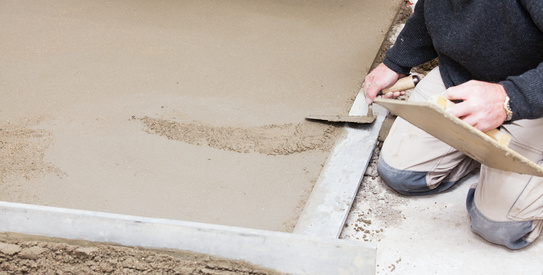
Access to the plastering, cementing and screeding profession
Are you thinking of starting up a business in plastering, cementing and/or screeding? Would you like to expand your existing business to include one of these services? In this case, you need to prove that you have the skills to start up such a business. If you don't have a diploma or experience in this field, you can obtain a certificate by sitting the central jury exam.

What activities require skills in plastering, cementing and screeding?
This includes coating walls and ceilings with plaster, plasterboard, mortar or cement, as well as repairs. These tasks are generally carried out by plasterers and screed layers.
If in doubt, contact a Business Counter. They can advise you on your personal situation.
Which activities are exempt?
Proof is not required for
- The installation or repair of plasterboard on walls and ceilings, if you're a business specialising in joinery or finishing.
- Coating and levelling mortar floors, if you are a business specialising in tiling, marble and natural stone.
If in doubt, contact a Business Counter. They will be able to tell you whether or not you qualify for an exemption.
How can I prove my skills?
Skills can be proven in two ways:
- With an educational or training diploma;
- With 3 years' full-time or 5 years' part-time professional experience within the last 15 years.
If you don't have either, you can obtain a certificate by sitting the exam for professional skills specific to plastering, cementing and screeding activities (20202) before the Central Jury.
Frequently asked questions about access to the profession
How do I know if my diploma grants me access to a profession?
A database of diplomas, degrees and certificates from all over the world helps you determine whether your qualifications meet entrepreneurial requirements. You can look up your diploma to find out which activities it gives you access to. If in doubt, contact a business counter. The Central Jury Service is not able to validate your qualifications.
Other than the company manager, who else can bring entrepreneurial skills to the business?
For a self-employed person (natural person), this person can be:
- A spouse;
- A legal cohabitant;
- A partner who has been cohabiting with the individual for at least 6 months;
- A self-employed assistant, parent or relative up to the third degree;
- An employee with a permanent employment contract.
For a business (legal entity), this person can be:
- The management body (e.g.: a manager of a limited liability company or a managing director of a public limited company);
- A company director (e.g.: an active partner in a limited liability company or a director of a public limited company);
- An employee with a permanent employment contract.
If in doubt, contact a Business Counter. They'll be able to tell you if you have the required skills for your activity.
What skills will be tested on the exam? What content does the exam cover?
The exam is divided into two sections: the first covers administrative knowledge specific to the construction sector, while the second assesses your professional skills. For the first section, please refer to the syllabus provided below. For the second section, we have provided a list of useful sources to help you prepare for the exam.
People who already have access to the profession in construction are exempt from the administrative section specific to construction. In this case, a copy of your CBE statement will be requested at registration.Section 1: Administrative knowledge specific to construction
- Registration and approval as a contractor;
- Rights and obligations of the subcontractor;
- Public procurement regulations;
- Decennial liability;
- The required insurance;
- Business contract, rights and obligations of contractor and project owner;
- Procedure and application for a building permit;
- Working drawings and specifications;
- Monitoring, inspection and acceptance of work;
- Safety regulations: General Regulation on Labour Protection, Code on Well-being at Work, safety coordination and work at a height;
- Quality policy and certification;
- Construction overheads and site risk management;
- Corroborating calculation and planning techniques;
- Reading plans;
- Environmental regulations on soil and waste;
- Environmental permit;
- Declaration of work.
Section 2: Skills in tiling, marble and natural stone
- Materials: types of cement, plaster and substrates, insulation and waterproofing products;
- Technical specifications (STS) relating to plastering, cementing and screeding activities;
- Verification, analysis, cleaning and preparation of substrates;
- Removal of existing materials, surface treatment, screeding, partitions and false plasterboard ceilings.
- The Scientific and Technical Centre for Building's technical information notes and quality standards relating to plastering, cementing and screeding activities.

Useful Technical Information Notes (TINs)
NIT 199 Les enduits intérieurs. 1ère partie NIT 201 Les enduits intérieurs. 2e partie : Mise en oeuvre NIT 232 Les plafonds suspendus NIT 233 Les cloisons légères NIT 251 L'isolation thermique des toitures à versants NIT 255 L'étanchéité à l'air des bâtiments NIT 257 Enduits sur isolation extérieure (ETICS) Useful sources
- KNAUF, GYPROC, CANTILANA, STO… : Technical documentation on all their products (plaster, plasterboard, coatings on external insulation, MS structures, RF system, etc.). In-plant training courses (better for technical and practical knowledge)
- KNAUF, ISOVER : Technical documentation on all their thermal and acoustic insulation products
- Constructiv : Documents related to the professions of plasterers and screed layers.
How does the exam work?
The administrative section is a computerised multiple-choice questionnaire. The section related to the profession is a written exam and consists of several questionnaires:
- Damp coatings
- Dry coatings
- Old coatings (lime, clay, etc.)
- Insulation
- Cementing and rendering
- Screed
- Reading plans.
How do I register? Follow the steps
All proceduresAny questions? Any problems?
info.jurycentral.dgo6@spw.wallonie.be
Office hours:
Monday: 2 – 4pm
Tuesday: 2 – 4pm
Wednesday: 9am – 12pm
Friday: 9am – 12pm081/33.40.00
Our offices are located at:
Boulevard Cauchy 43
5000 NAMUR
Are you looking for other solutions for your project?

Receive personalised advice and quickly find the answers to your questions. Find the help you need on 1890.be.
Discover other solutionsOther state aid

Innovation, training, exports, consultancy... Take a look at all the state aid available to Walloon companies.
To the Midas database